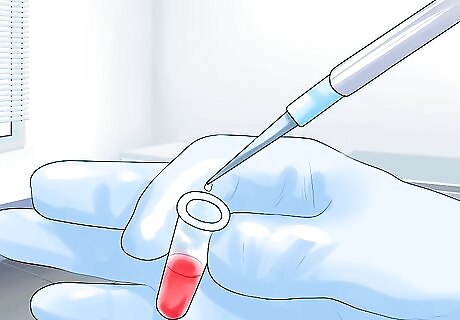
views
Steps

Be sensitive to check into nonspecific health issues. Being difficult to diagnose, it's so important to not ignore a bunch of recurring symptoms that are chronic/nagging (irritating): Abdominal pains and/or back pains Nausea/digestive difficulties Loss of appetite Unexplained weight loss Jaundice(There is a summary discussion of symptoms before the "Tips" section below.)

Consider diagnosis with new-onset or long standing type 2 diabetes as a good reason to prospectively combine three tests for biomarkers that are used for indicating pancreatic cancer -- CA 19-9, and newer tests microRNA-196, and microRNA-200. Why? When these tests were studied in connection with diabetes, a large majority of the participants found to have pancreatic cancer were also diabetic. It was reported that using all three tests in harmony significantly improved the sensitivity for results specific to detecting pancreatic cancer. Cancer marker testing can be worthwhile if you and your doctors have some reasons to suspect there are symptoms of pancreatic cancer. Tests are not conclusive, because some markers can be caused by several other problems. Be aware that there is not one simple test or set of defined symptoms that can readily screen for/or detect pancreatic cancer.
Noticing the Early Symptoms of Pancreatic Cancer

Watch for jaundice. One of the first signs of pancreatic cancer can be jaundice, also known as icterus, which is the yellowing of the skin, eyes and mucus membranes due to too much bilirubin in the bloodstream. Pancreatic cancer blocks the ducts that release this bile into your intestine, causing it to build up in the blood and turn skin and eyes yellowish. If you have jaundice, your stool will also be light, your urine becomes dark, and your skin will feel itchy. Look at your skin and eyes in a well-lit mirror to check for yellow discoloration. Jaundice also causes itchy skin. The parts of the eyes that turn yellow are called the sclera, or the white part of your eye. To confirm jaundice (if the yellowing is not so obvious), your doctor may test your urine for bile or order a blood test.

Take notice of a sore abdomen. One of the first signs of pancreatic cancer can sometimes be a diffuse abdominal aching and soreness, although many people don't feel any pain until the cancer is advanced. The pancreas gland is located behind the stomach and in front of the spine — pretty much in the middle of your belly. It secretes insulin (for blood sugar control), hormones and digestive enzymes. If your belly soreness doesn't go away after a week, contact your doctor. Palpating (deeply touching) your pancreas for mild-to-moderate swelling is difficult and virtually useless for doctors because the gland is positioned behind and close to other organs. Because pancreatic cancer often causes the liver and/or gallbladder to swell, which are easier to palpate and detect, the condition may be misdiagnosed as liver cirrhosis or cholecystitis. Due to abdominal tenderness, fatigue and diarrhea, the early stages of pancreatic cancer can mimic other disorders or infections, ulcerative colitis, Crohn's disease and irritable bowel syndrome.

Be alert to fatigue and weakness. Another early sign of pancreatic cancer -- as well as in most other types -- is a general feeling of tiredness, fatigue and weakness, also called malaise. During the early stages of pancreatic cancer, you'll likely experience unexplained tiredness and lose motivation to exercise or even leave your home.

Be suspicious of high blood sugar (glucose). One of the main functions of the pancreas gland is to produce the hormone insulin, which regulates glucose from the blood and into cells, from blood vessels, to be used for energy. Therefore, when the pancreas is cancerous and dysfunctional (not making enough insulin), blood sugar stays in the blood and levels tend to be high. When your blood glucose levels get too high, you may have symptoms like lethargy (feeling tired and fatigued), polydipsia (extreme thirst), weakness, diarrhea, weight loss, and polyuria (excessive urine). To measure your blood sugar level, see your doctor for a blood test. Another simple way to tell if you have high blood sugar is a urine test. This will show if your body isn’t controlling your blood sugar, and if it’s building up in your urine.

Look for chronic diarrhea or very light colored stool. Another potential early sign of pancreatic cancer is chronic diarrhea. This is caused by excessive amounts of glucagon, or sugar, going unregulated in your body. If your stool is light-grey or nearly white, consistently lighter in color than normal shades, this indicates a build-up of bile in your body. Another clue that your pancreas is dysfunctional by not producing or releasing enough fat-digesting enzyme (bile) is that your stool will have spots of oil floating on the water or look greasy, smell worse than usual and fecal matter will tend to float in the toilet bowl.
See your doctor if you begin experiencing these symptoms. Even experiencing just one symptom on its own might be an early sign of pancreatic cancer. If you have one or more of these symptoms, make an appointment with your doctor right away. Note down all of the symptoms you’ve been experiencing and describe them as best you can to your doctor.
Using Diagnostic Tests

Get all the appropriate blood tests. Your doctor or an oncologist (cancer specialist) will likely order a series of blood tests once you present with any or all of the above-mentioned symptoms. Several types of blood tests are useful to help diagnose pancreatic cancer and rule out other causes of abdominal symptoms, such as: complete blood count, liver function tests, serum bilirubin, kidney function test and looking for various tumor markers. Tumor markers are substances that can sometimes be found in the bloodstream of a cancer patient. Two that are related to pancreatic cancer are called CA 19-9 and carcinoembryonic antigen (CEA). These tumor markers are not elevated in all people with pancreatic cancer and some who don’t have any cancer might have higher levels for some other reason, so they are not really accurate indicators but are relatively cheap and non-invasive so are helpful in determining whether or not to test further. Looking at hormone levels is useful as some (such as chromogranin A, C-peptide and serotonin) are often elevated in people with pancreatic cancer.

Make sure to have all the essential imaging tests done. Once in the hands of an oncologist who strongly suspects pancreatic cancer (based on telltale symptoms and blood tests), a number of imaging tests will be performed. Common diagnostic tests include: a CT scan and/or an MRI of the abdomen, endoscopic ultrasound of the pancreas and endoscopic retrograde cholangio pancreatography (ERCP). Once a test strongly suggests cancer, more detailed tests are done to see if the cancer has spread — this methodology is called staging. An endoscopic ultrasound uses a device to take images of your pancreas gland from inside your abdomen. The endoscope is sent down through your esophagus and into your stomach to take the images. An ERCP uses an endoscope to inject dye into your pancreas, then an abdominal x-ray is taken to highlight the bile ducts and other parts of the gland..

Consider a biopsy for confirmation. Once a number of tests have seemingly confirmed a diagnosis of pancreatic cancer, a final procedure to be completely sure and to determine which cells are most involved is called a pancreatic biopsy or tissue sample. Biopsies require anesthesia and can be done in three different ways: percutaneous, endoscopic and surgical. A percutaneous biopsy (also called fine needle aspiration) involves inserting a long, thin, hollow needle through the abdominal skin and into the pancreas gland in order to remove a small piece of tissue / tumor. An endoscopic biopsy involves inserting an endoscope down the esophagus, through the stomach and into the small intestine to get close enough to the pancreas to cut off a tissue sample. A surgical biopsy is most invasive because it involves making incisions into the abdomen and inserting a laparoscope to get a sample and look around to see if the cancer has spread.
Summary of Symptoms

Watch for subtle and nonspecific signs and symptoms: These may indicate pancreatic cancer, or some other ailment. Since early signs and symptoms may be ambiguous, they are often not associated with the pancreas until the disease is quite advanced. Early issues include: Moderate abdominal and/or back pain Nausea (not vomiting) Loss of appetite (food is less desirable) Unexplained significant weight loss Yellow jaundice (which also causes itchy skin)

Beware that in later stages there may be: Chronic pain Severe nausea Frequent vomiting Malabsorption of food Blood glucose control problems/Diabetes (since the pancreas makes and releases insulin but becomes dysfunctional).

Realize that the prognosis and staging of pancreatic cancer is not easily tested. It is not easily scanned nor viewable behind the stomach and near the small intestines. The stages are: Stage 0: Not spread. A single layer/small group of cells in the pancreas -- not yet visible on imaging tests or to the unaided eye. Stage I: Local growth. Pancreatic cancer is growing in the pancreas, Stage 1A is less than 2 centimeters (0.79 in) (approx 3/4 in) across, but Stage IB is greater than 2 centimeters. Stage II: Local spread. Pancreatic cancer is larger, protruding outside the pancreas, or has spread to nearby lymph nodes. Stage III: Spread nearby. The tumor has expanded such as encasing nearby major blood vessels or nerves (unlikely to be operable, unless very limited spread) -- as well as into nearby lymph nodes -- but is not known to have metastasized to any distant organ. Stage IV: Confirmed distant spread. Pancreatic cancer has been found in distant organs such as lungs, liver, colon, etc. -- probably inoperable.




















Comments
0 comment